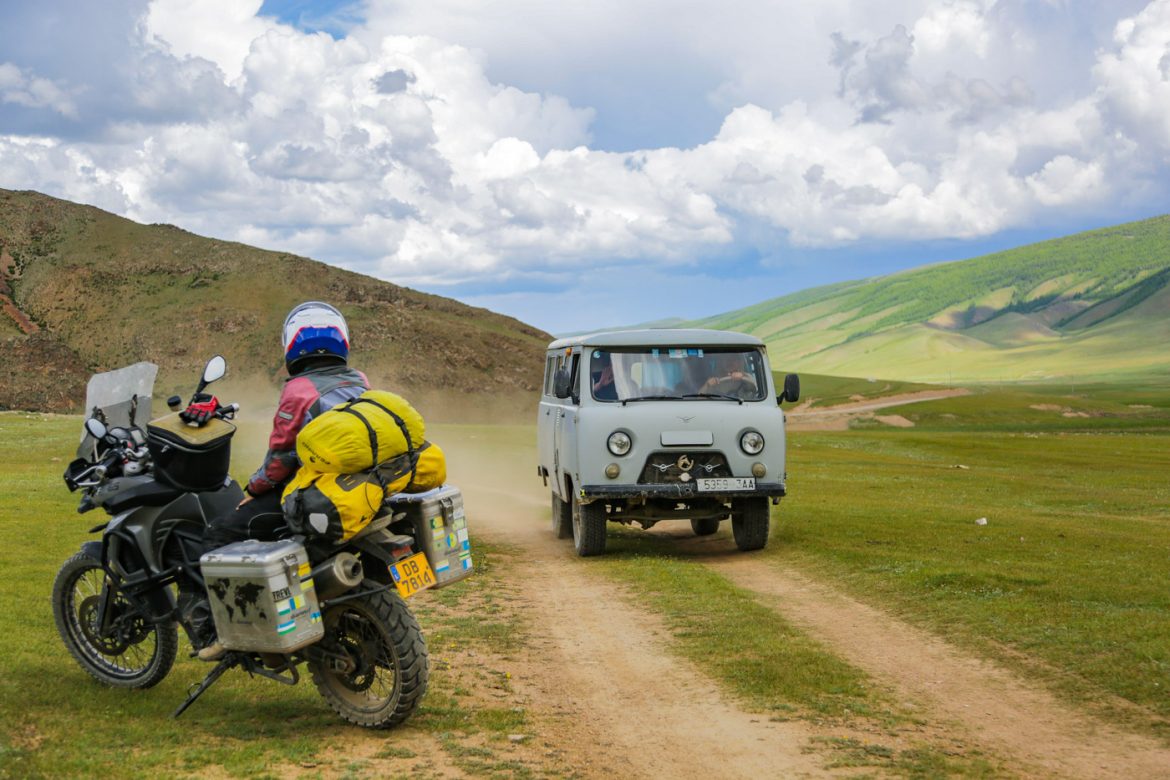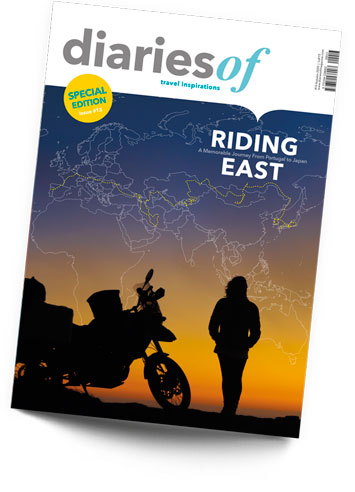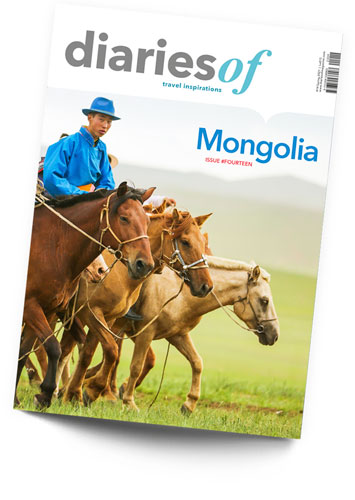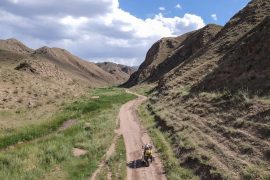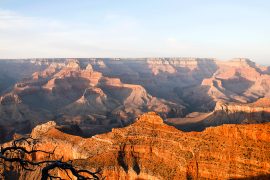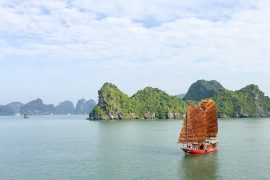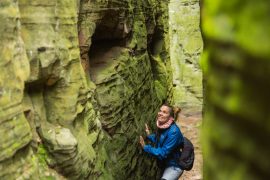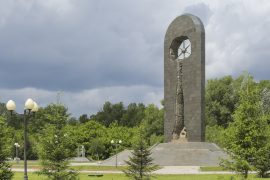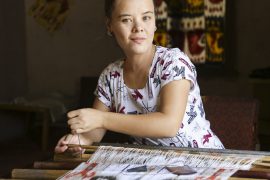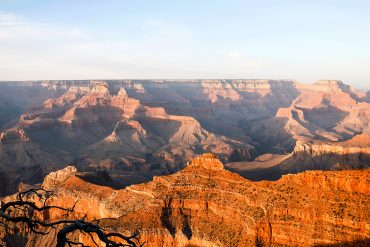Visiting a country for the first time is an opportunity to verify whether the preconceived ideas we had formed about that country are true or not. For us, Mongolia was the homeland of the vast empire that was conquered by Genghis Khan, a realm that eventually collapsed to its titan neighbours: China and Russia. As we approached Mongolia, our minds were filled with images of brave horsemen, frightful warriors and nomadic tribes in the vast, scenic steppes.
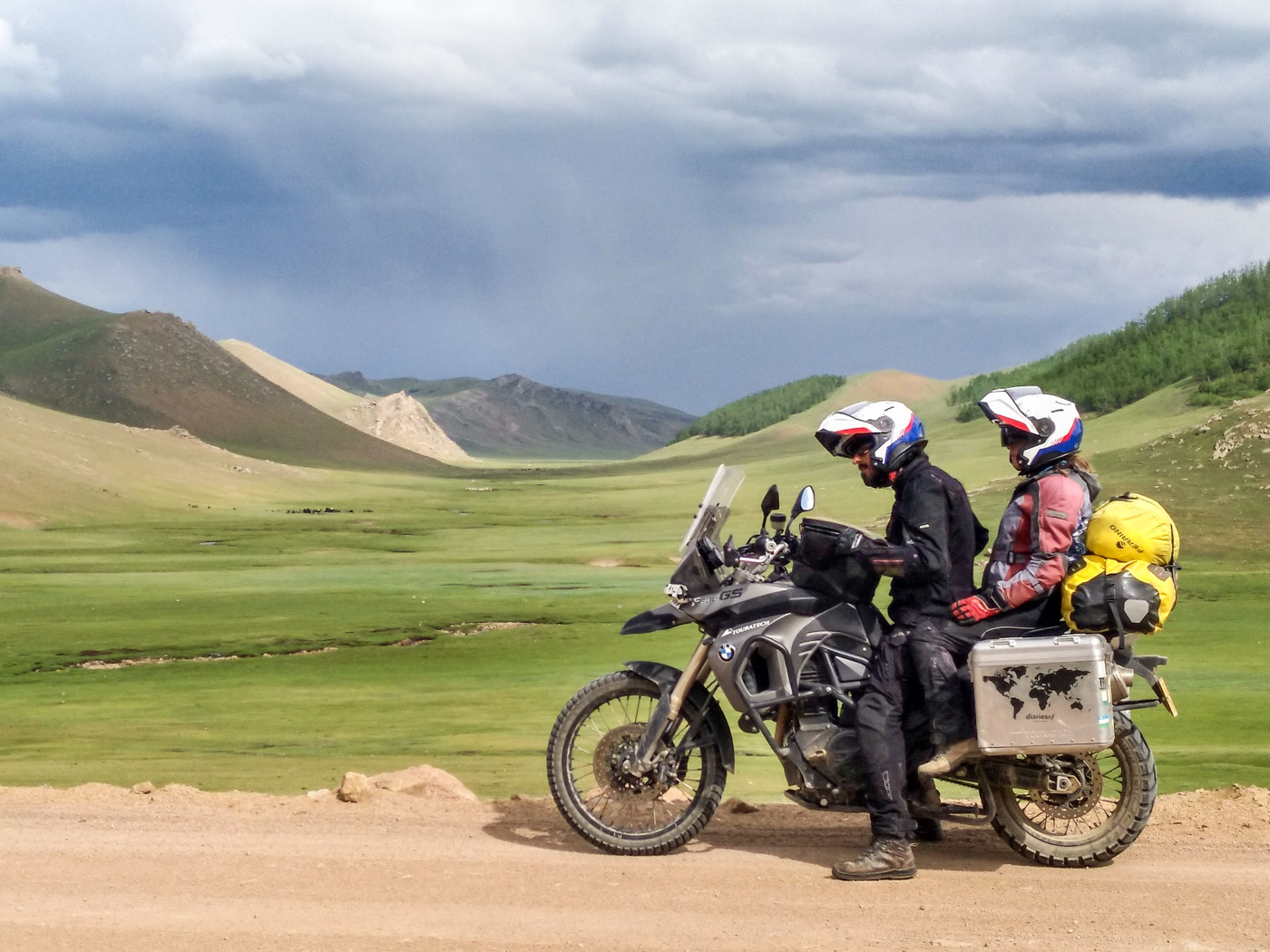
We left the Russian border behind, but did not see the one from Mongolia straight away. Occasionally there is a no-mans land between two neighbouring countries, especially on the most remote borders. We kept riding until, after a couple of kilometres, we began to wonder whether we had perhaps missed it after all.
A small building in the distance encouraged us to continue. Surely, we would find someone there who could tell us where exactly we were. Unfortunately, once we arrived we didn’t see a soul. Actually, the place looked like an abandoned storehouse. We couldn’t help but smile at the lowered arm of a barrier, standing there alone in nature, like one of Magritte’s doors, easily bypassed. A pointless existence. We prepared to turn around and start searching for the missing border, when a man with the most stupefied face sprang out of the house. He had obviously not expected visitors and was only slowly pulling himself together.
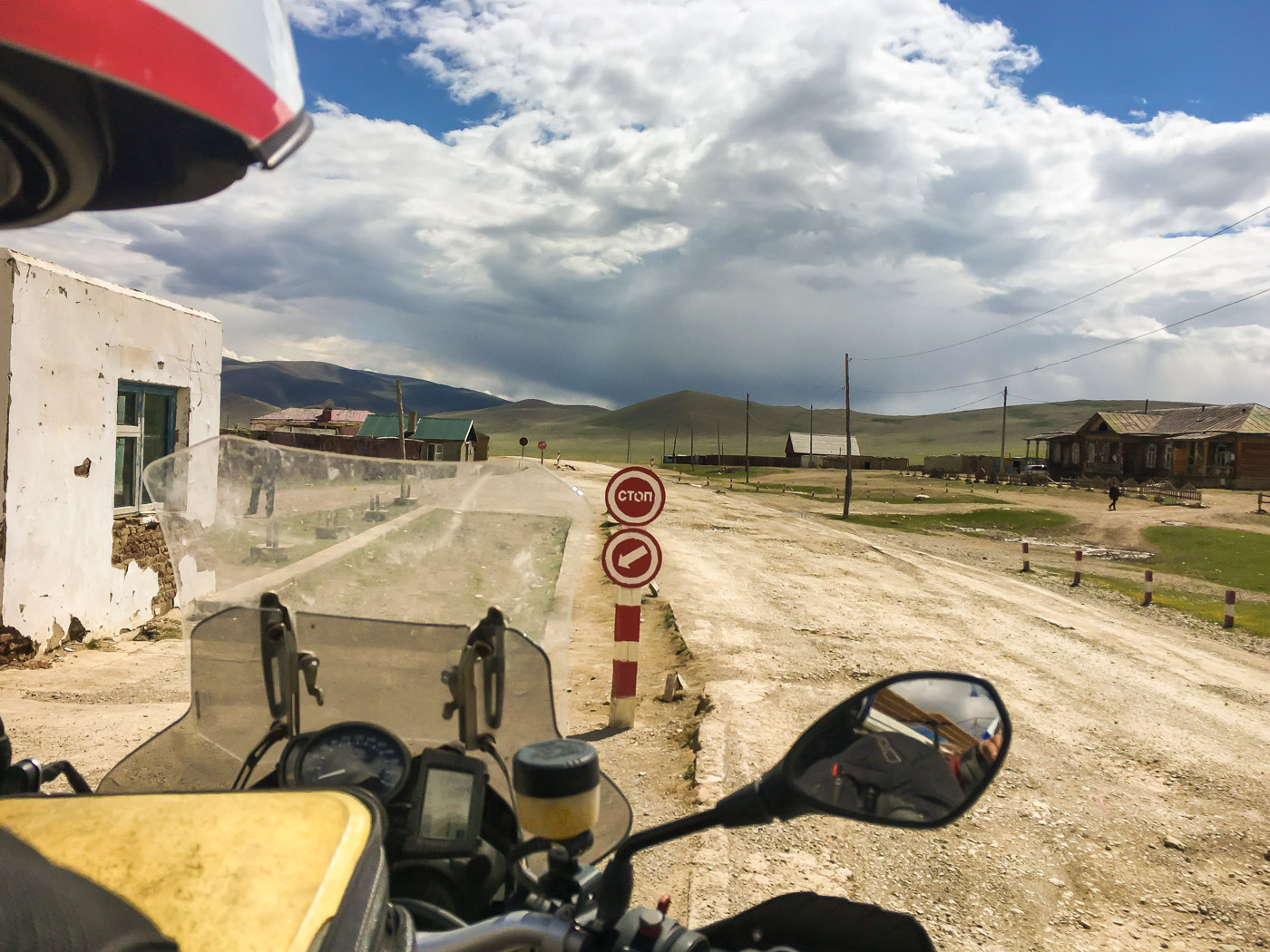
‘Passports’ he babbled. Well, well, it looked as if our border hunt was over even before we got started. The guard was genuinely more surprised by our presence than we were by the facilities of an official border. In one swift movement, he returned our documents with his right hand and, almost simultaneously, he pulled a cord that lifted the barrier with his left hand, waving us through with a nod of approval.
With only 30 days to explore the 18th largest country in the world, we were divided between rushing, to see as much as possible or riding slowly, to get the measure of the country. Our trip through Mongolia ended up being a combination of both – we had to abandon the idea of visiting some of the most remote tribes, such as the reindeer herders, the Tsaatan – hopefully this will just be a postponement till the next time we visit Mongolia. But still, we did not rush; we took the time to camp near gers, to meet the nomads and to find out about their lifestyle, their culture and their beliefs.
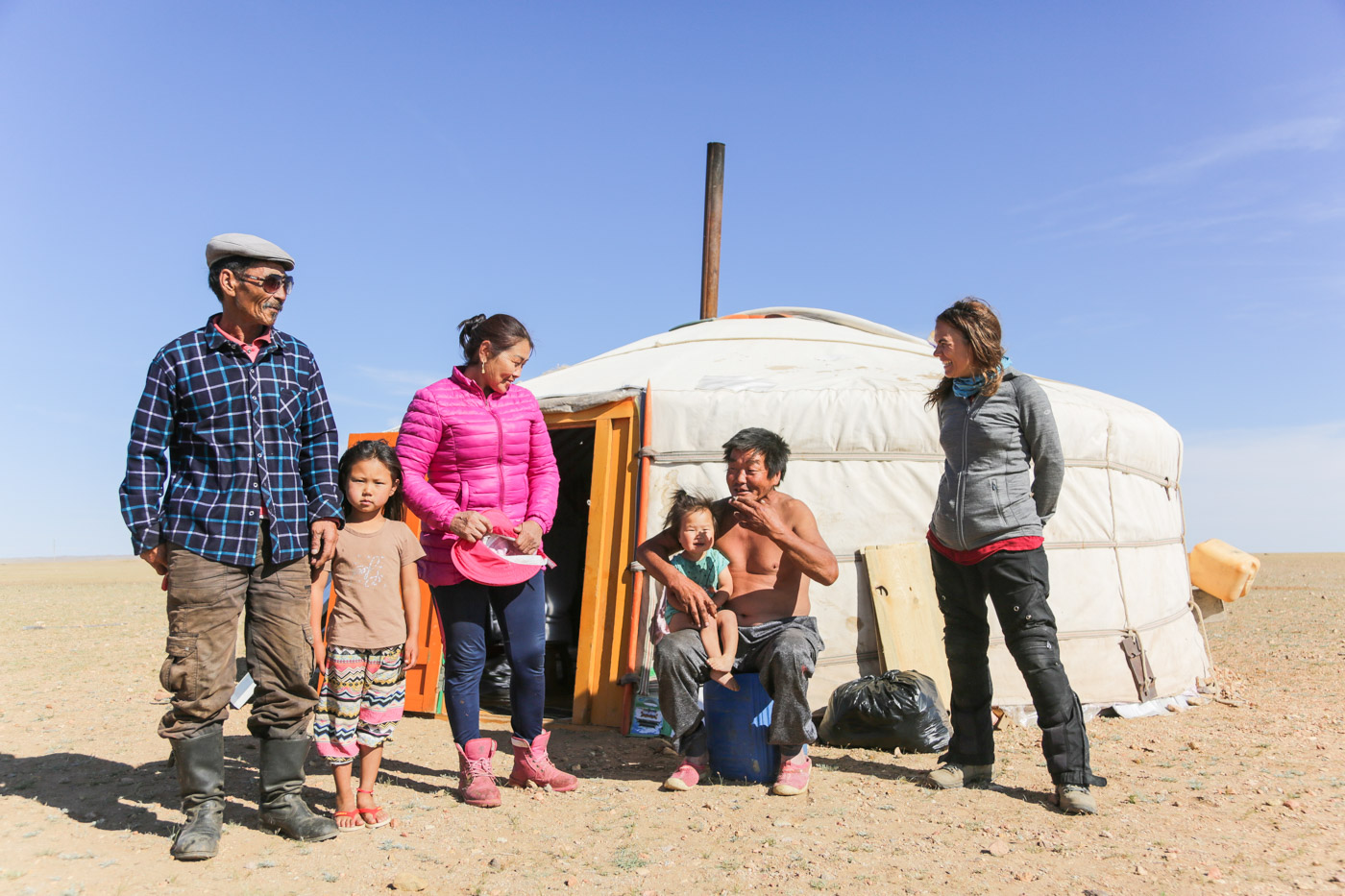
Our first twenty kilometres in Mongolia, from the border towards Olgii, gave us a good idea of what to expect from Mongolian roads. There would be a lot of off-roading, and many dirt roads, that tend to get very slippery with rain. But we were lucky; Mongolia lived up to its reputation for being the land of the blue sky and the roads remained dry throughout our trip.
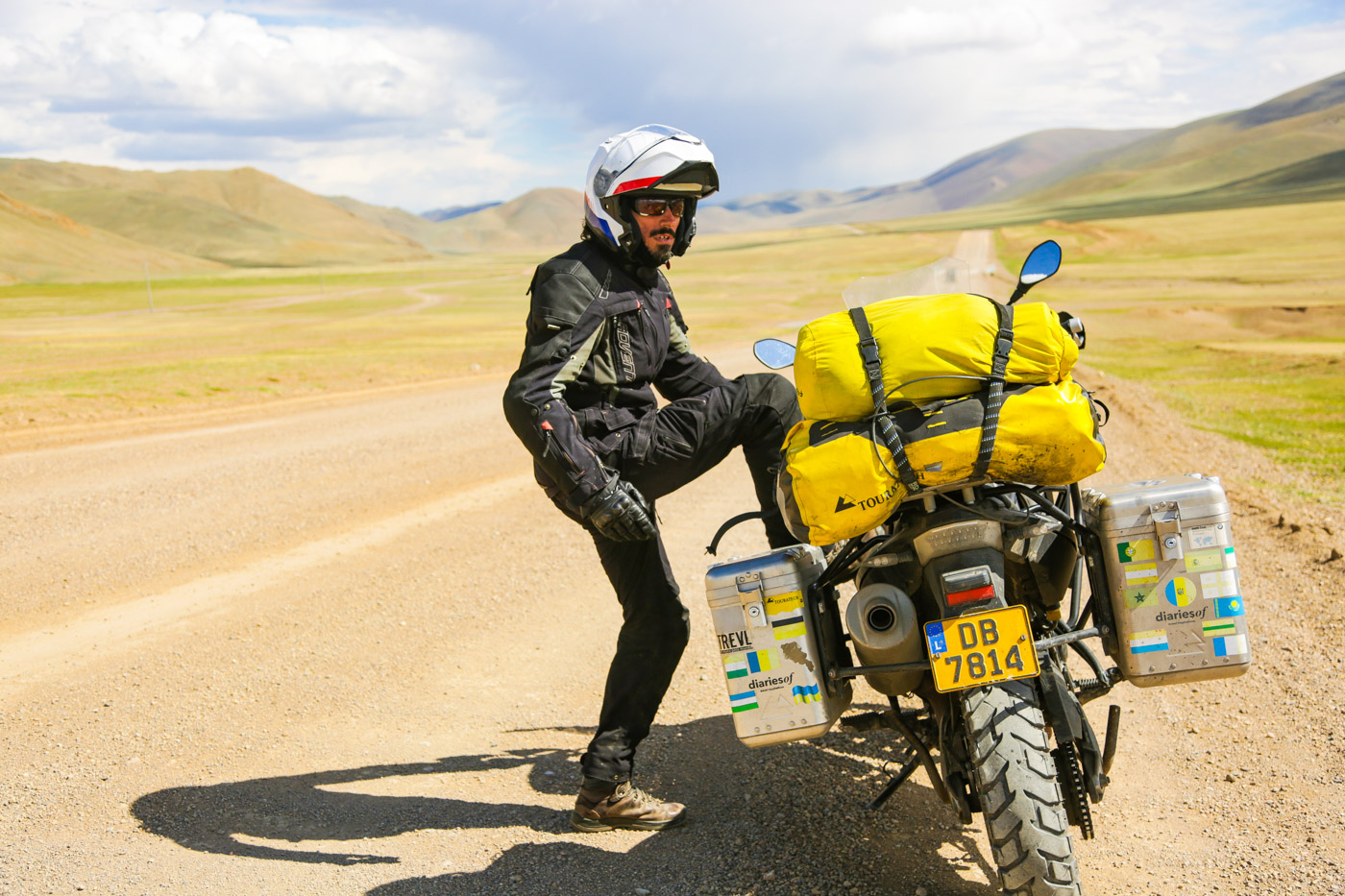
In Olgii we saw another foreigner motorbike, a Honda Transalp. It belonged to Oscar and Cristina, a charming couple from Northern Spain, who were also planning to find a route that would take them slowly to Ulaanbaatar. They were very friendly and we liked their company straight away, which explained why we ended up making part of the journey together.
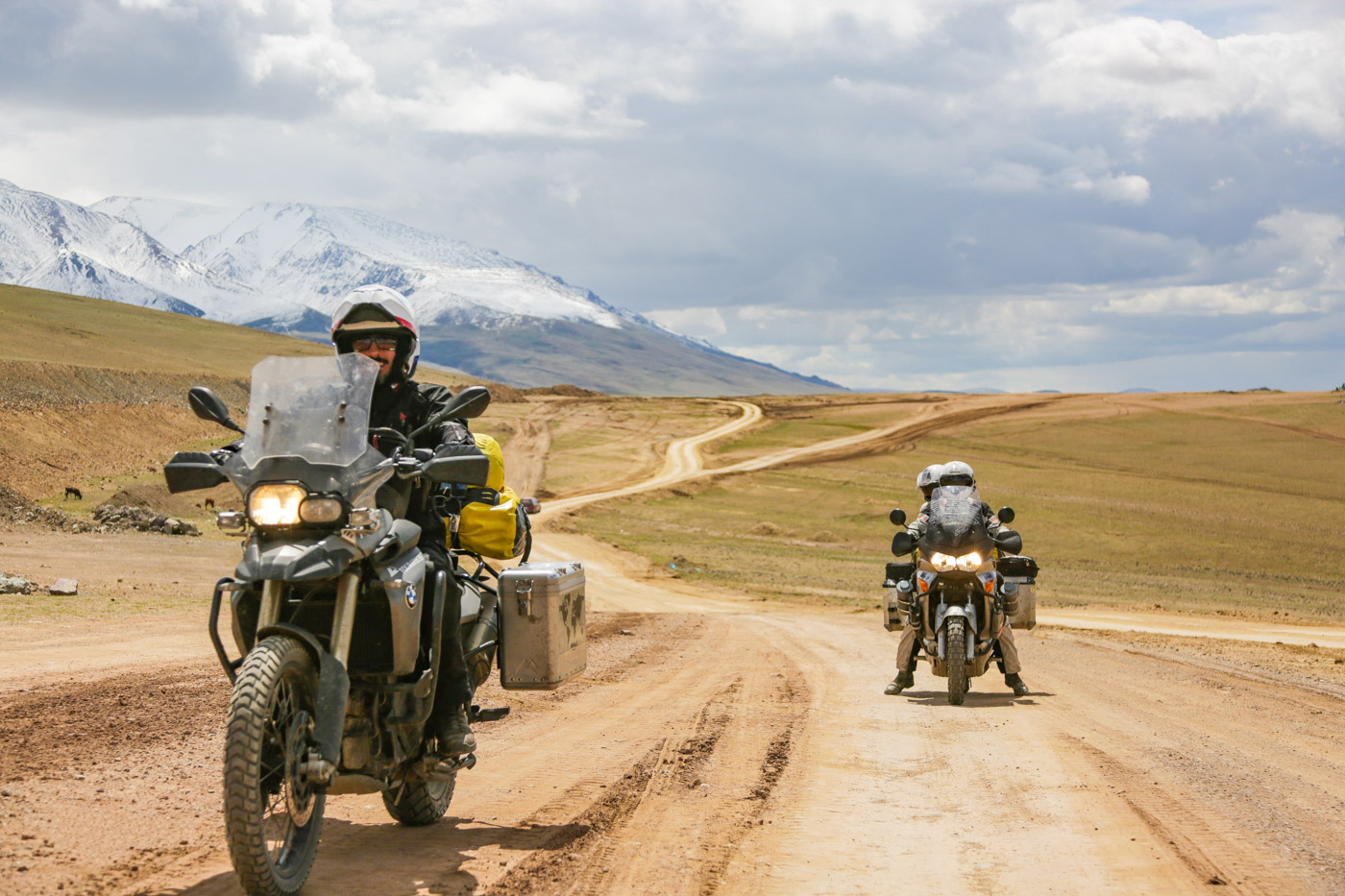
Our motorcycle journey throughout Mongolia soon fell into a simple routine: riding, eating and setting up wild camps. Without any ‘must-visits’, ‘must-dos’, or must-sees’, along our route, we were utterly free from obligations, from expectations, and from plans. Even the ‘must-do’ habits of combing one’s hair, wearing fresh clothes or having a shower had long been packed and forgotten at the bottom of our suitcases. They were swapped by wild camps in stunning locations, warm bonfires at dusk and gazing at the stars while enjoying the company of our new-found friends.
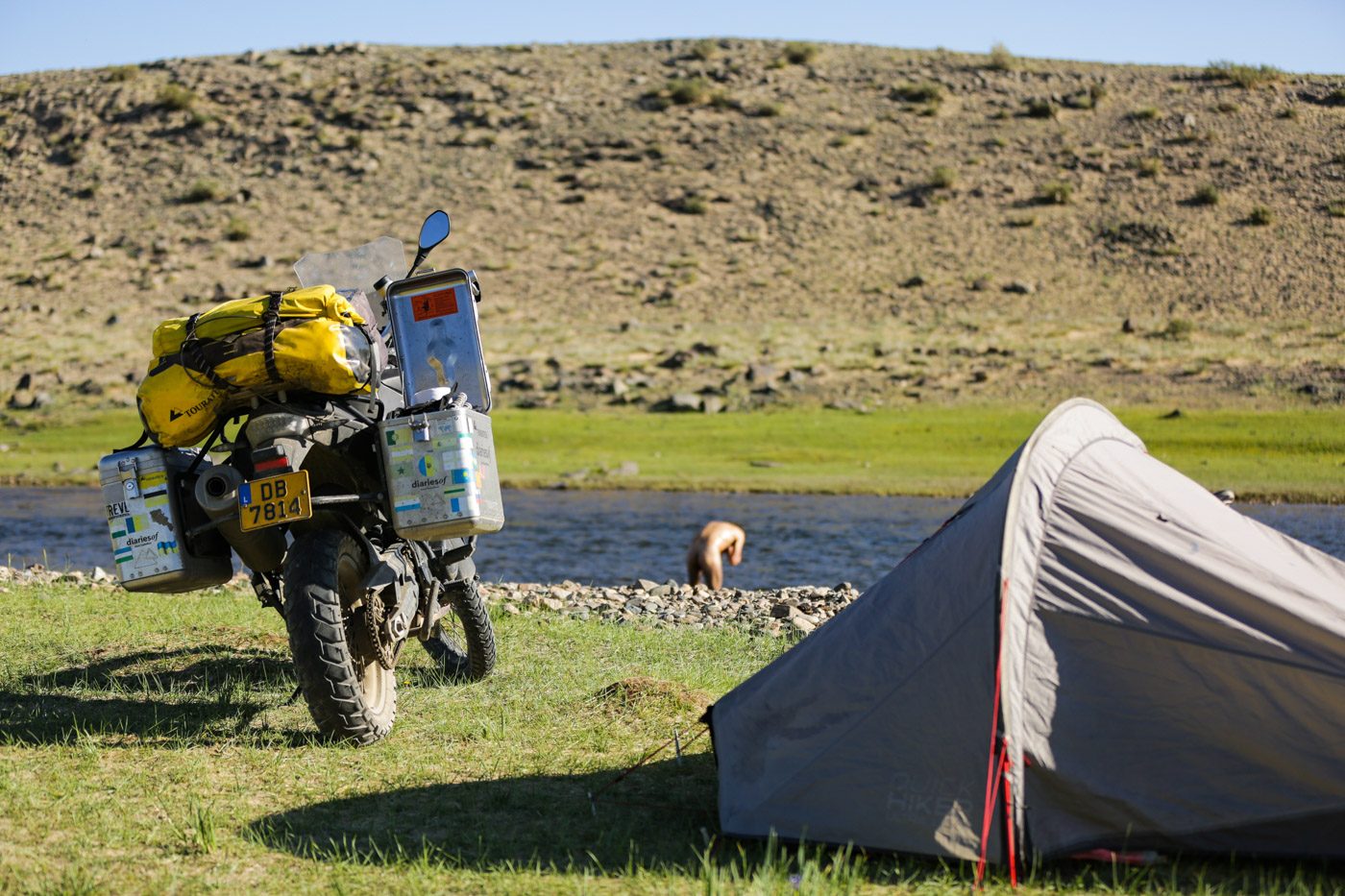
We felt free. We felt like nomads on the road, with the sole purpose of travelling east to reach Ulaanbaatar, at some point, preferably before our thirty day visa expired. Apart from that, we were free to do as we wished. All that remained for us to do was enjoy the ride, be amazed by the landscape, feed ourselves and find a safe place to pitch the tent and spend the night. Could life get any simpler yet any more meaningful than this?
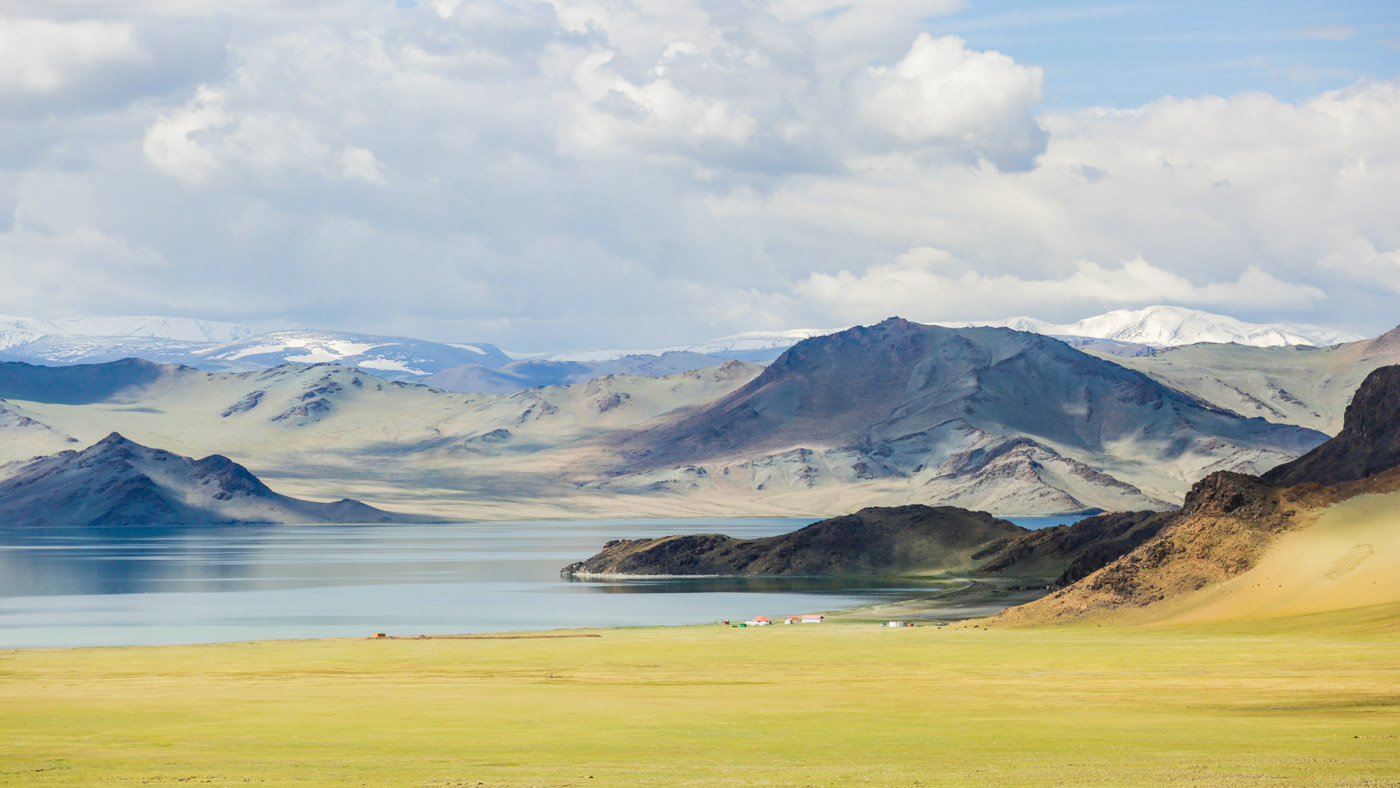
Well, perhaps life couldn’t get any simpler, but life was there to remind us that it certainly could get more complicated. These hurdles usually came in the shape of a river crossing (when a bridge had fallen and the crossing had to be done through the water!), or in the landscape falling open in all directions! This was one of the beauties of Mongolia, and something we cherished very much – the endless steppe, the boundless extensions of Mongolian grassland! But, it frequently came with an additional challenge, especially on the leg from Altai to Uliastai: somehow the dirt road multiplied into several tracks and we didn’t really know which one to follow as they all spread out. The map showed the existence of one clear road. Where did all these tracks come from? Which track was the right one? After a meticulous analysis of the map and prolonged discussion among the four of us, we took the decision the same way as other important decisions are taken, with an impromptu rock-paper-scissors-game! So eventually we headed straight ahead. We reckoned that they all probably led to the same place, though. That was not so, so, every now and again, we had to drive across the field in order to get back on the right track, because the one we had chosen was leading us in the wrong direction. It was also here that we first found sand in Mongolia. It wasn’t so much that we couldn’t continue, but because of our weight – i.e. the weight of the motorcycle and all the gear – we did have to ride more carefully, to try to avoid the deeper sandbanks.
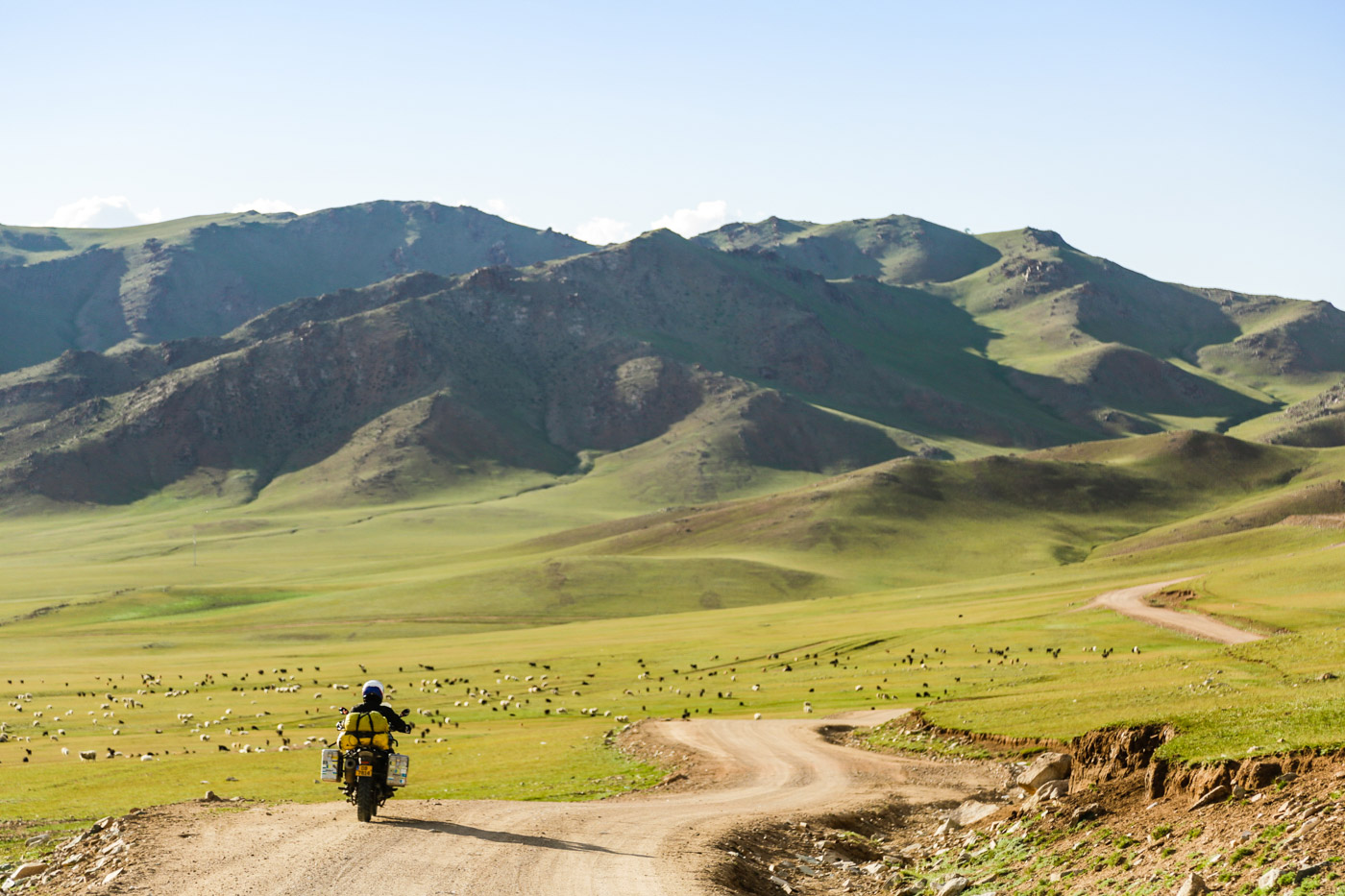
It was also a joy not to have to share the road with trucks or impatient drivers. Instead, we shared it with goats, camels, yaks and horses. Whenever a flock of goats approached the road, it would take a good while until all animals had passed. Horses were much faster, and also more daring. It occasionally happened that we had to share the lane, side-by-side with a herd of running horses. Yaks seemed to have developed the habit of stopping in the middle of the road to stare at us. It could have been their size, or that one experience, where one defiant yak came too close for us to feel comfortable. Whatever the reason, with yaks, we learned just to stare back from a safe distance, until they eventually resumed their crossing.
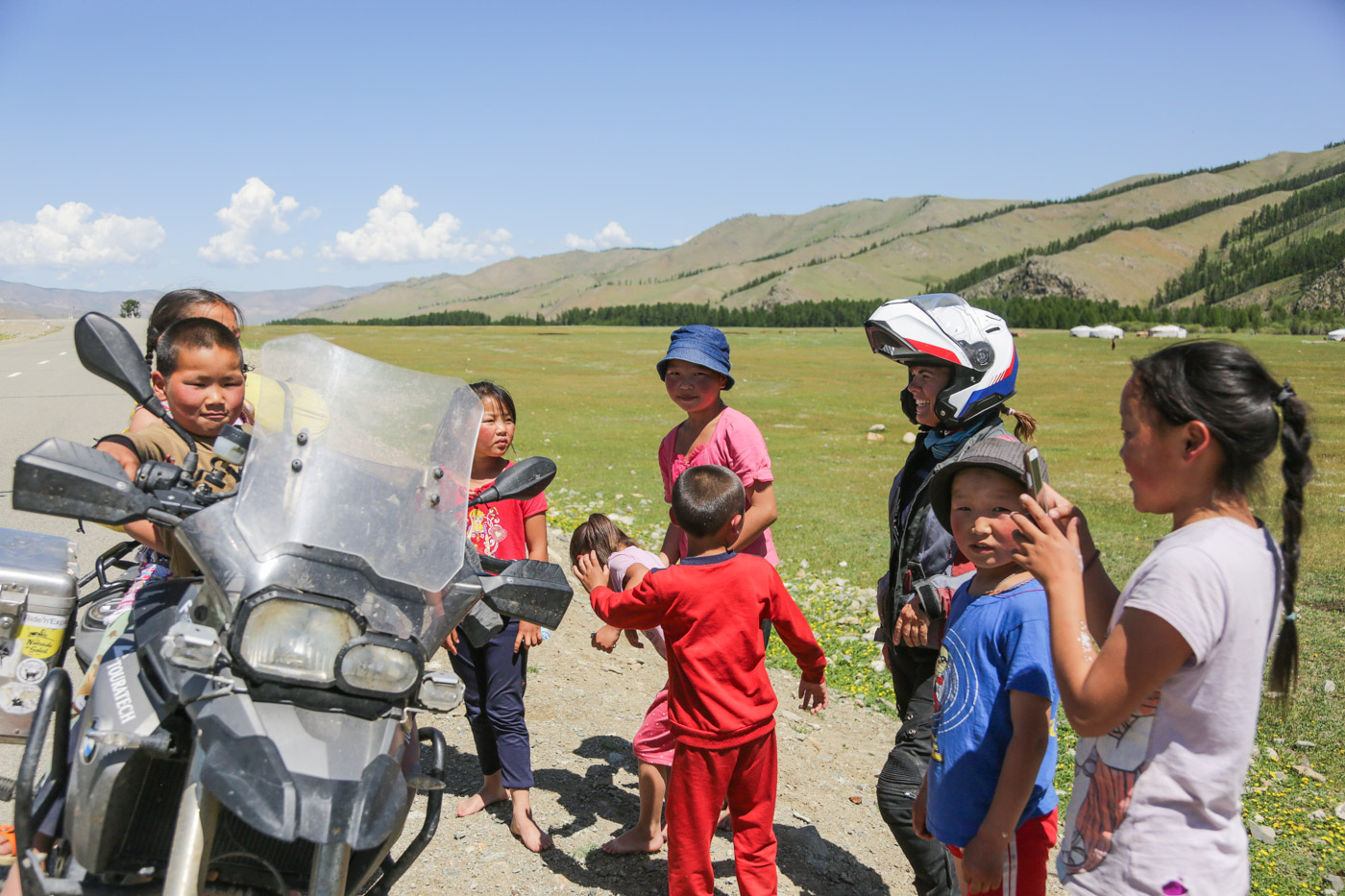
We needed a couple of days to drive from Uliastai to Tsetserleg, two of the few villages on our route. As there were few villages on the road, we took the opportunity to approach the people from the gers that appeared throughout the landscape. We never really found settlements of gers; only two or three together, and usually belonging to the same family. Sometimes we camped near them, other times we were invited to stay with the family.
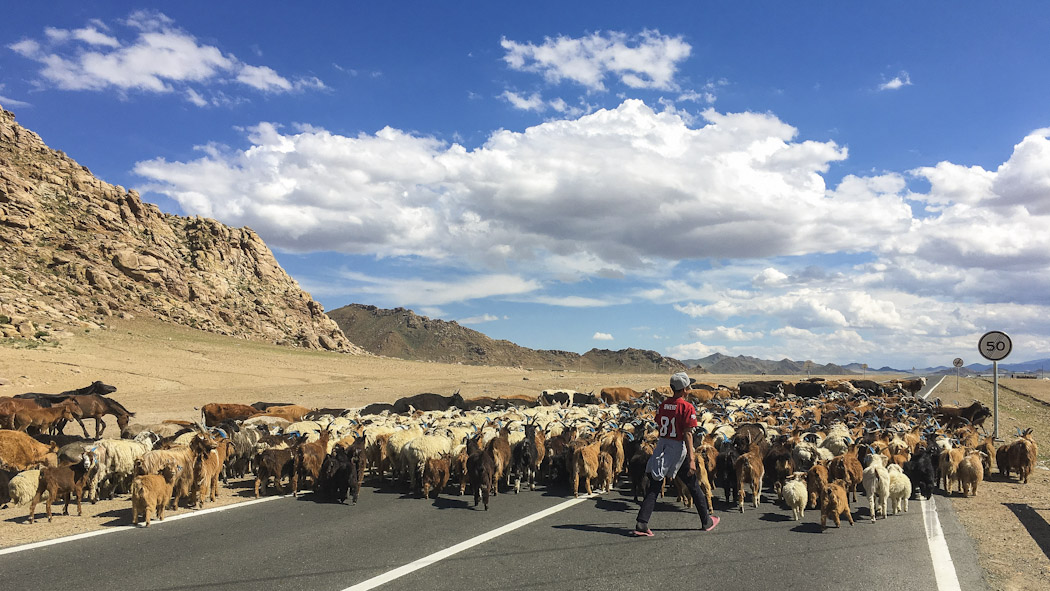
From the outside, gers look like fragile dome-shaped tents, but their structure is actually robust. Entering a ger is like entering into the magic world of Alice’s rabbit hole. They are like big flats that accommodate all of the family’s furniture (beds, wardrobes and cupboards) in one single room. Comfortable and cosy. The final touch is given by the colourful rugs that coat the floor, walls and roof giving it a snug and homely feel. We weren’t even surprised that some families had electricity, most often from batteries or solar panels, and with this sometimes even TV from satellite dishes.
Staying in a ger, or camping next to one, was an opportunity for us to witness their nomadic lifestyle first-hand; one in which everyone in the family participates, including the kids. It was very early in the morning, when we woke up to the noise of someone working outside. Mother was the first to come out.
‘Sain uu’, she greeted us, while preparing a bucket to milk the goats. Her ruddy cheeks reminded us of how fresh the morning was. Even though we were in summer, nights got chilly in the steppe; we were above 1,500 metres after all.
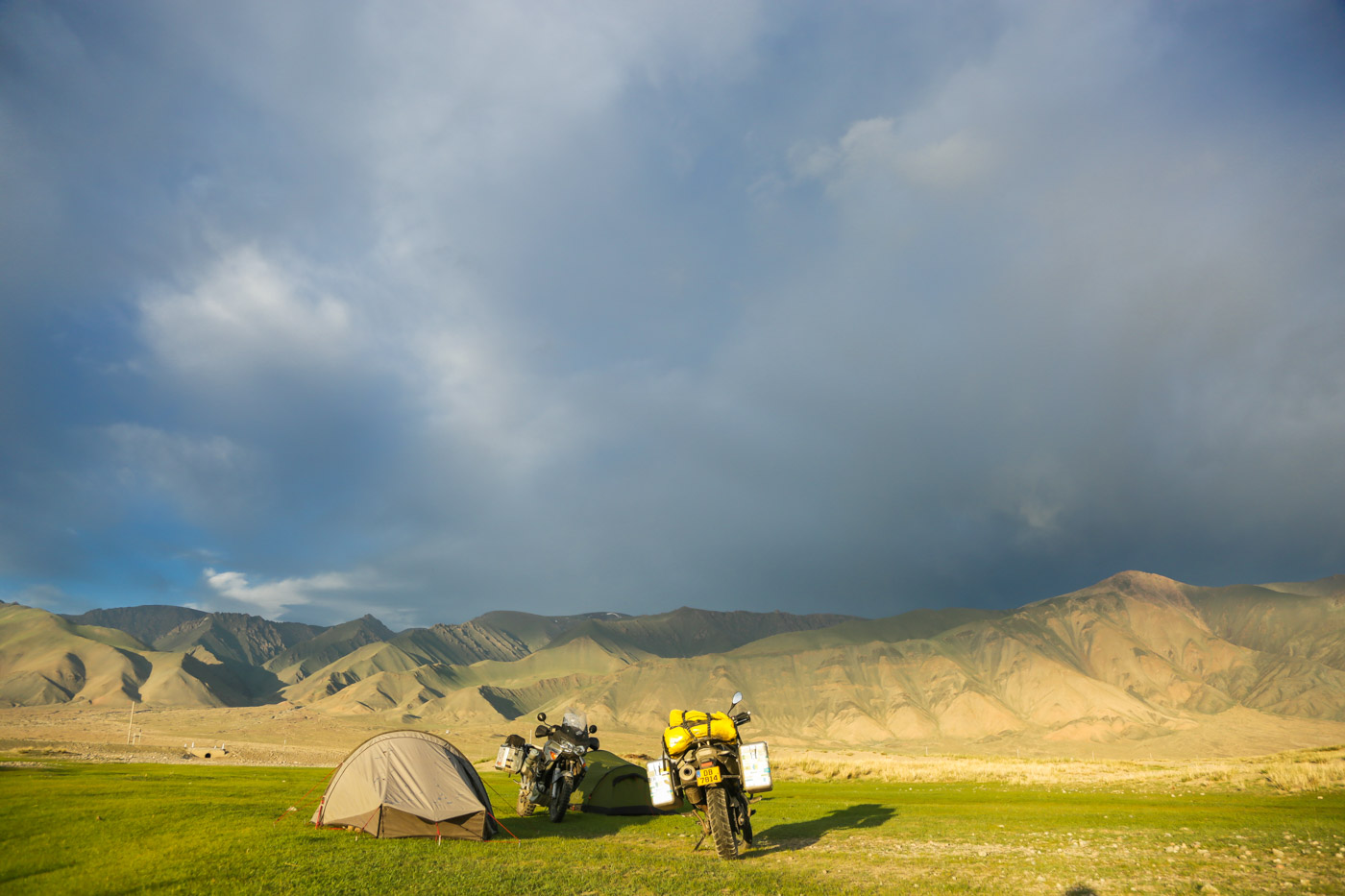
The kids played outside in their pyjamas, indifferent to the temperature. They always peeked inside our tent, curious about these foreigners with weird ‘gers’ where no one could stand upright. We couldn’t help but notice their red cheeks, just like their mother and father. A glimpse at the motorbike’s side mirror showed pale cheeks on our skin, although we were breathing the same cool air! A mystery we have still to solve…
Soon after breakfast, the father and elder son mounted their horses, to lead the goats to a spot where grass was more abundant. They need all the grass that grows in the immense steppe, for all of the goats, sheep, horses, and also yaks, that they raise and that graze in the open. In all of Mongolia we didn’t see any tall grass. The vast hilly landscape was perfectly neat, as if they had been cut by a lawn mower.
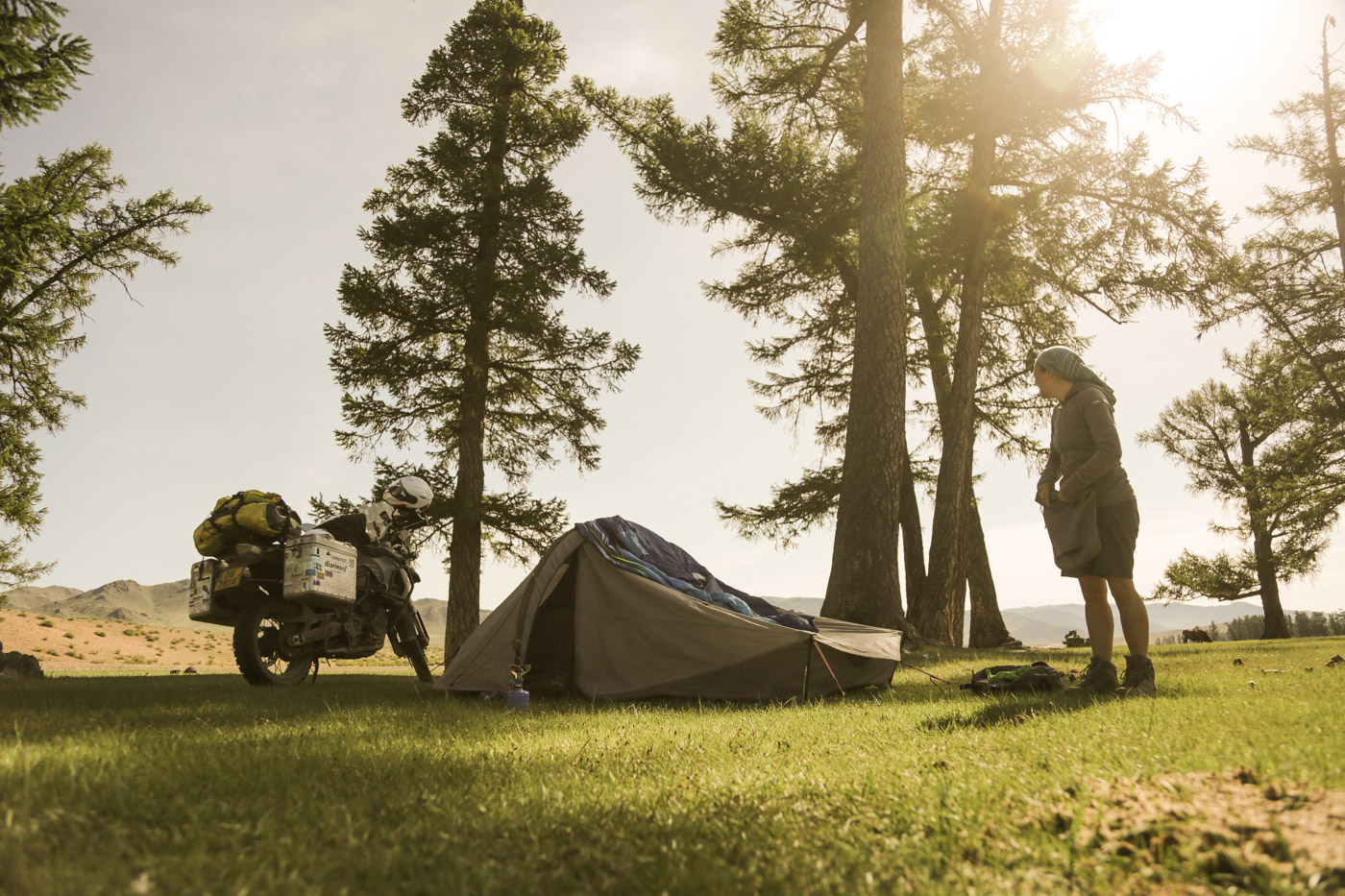
After clearing camp and letting the kids sit on the bikes for a delightful moment, and after an exchange of hearty smiles, it was also time for us to continue. The kids ran after us until they got tired and we could finally concentrate on the flatland ahead of us. At least until our stomachs asked for food. There were always small grocery stores near villages that sold the ever-popular instant noodles. In the steppe we cooked them ourselves, on our gas stove. When we were lucky, we found a ger or a small stall selling tsuivan (mutton and noodles). Anyway, we avoided full stomachs; never a good thing when riding a motorbike, especially in Mongolia where the roads are not so easy to negotiate.
Read about our memorable 47,000 kms adventurous motorcycle journey from Portugal to Japan. This magazine is all about the freedom we felt, the encounters we had and the moments we experienced. Let us inspire your next big trip. Get inspiration and enjoy the ride!
> Have a look inside our Riding East Magazine!
Having no expectations goes hand in hand with discovering big revelations; at least that’s what happened to us in Kharkhorin. The town itself looked just like Uliastai or Tsetserleg, but unlike these places, it offered a really nice hotel and a couple of hostels, which led to the obvious question: why? Because it is here that, lost in the middle of the steppe, lay the ruins of the former capital of Genghis Khan’s Mongol Empire, Karakorum. Nothing is left of the old city, which was destroyed by the Ming troops. But, in the 16th century, its remains were used to build the Erdene Zuu Monastery (in situ), which happens to be Mongolia’s largest and most significant religious centre. Due to its importance, it is one of the few Mongolian UNESCO heritage sites that also serve as a museum. Erdene Zuu means ‘one hundred treasures’ and this number refers to the one hundred stupas that form the exterior walls of the sacred place.
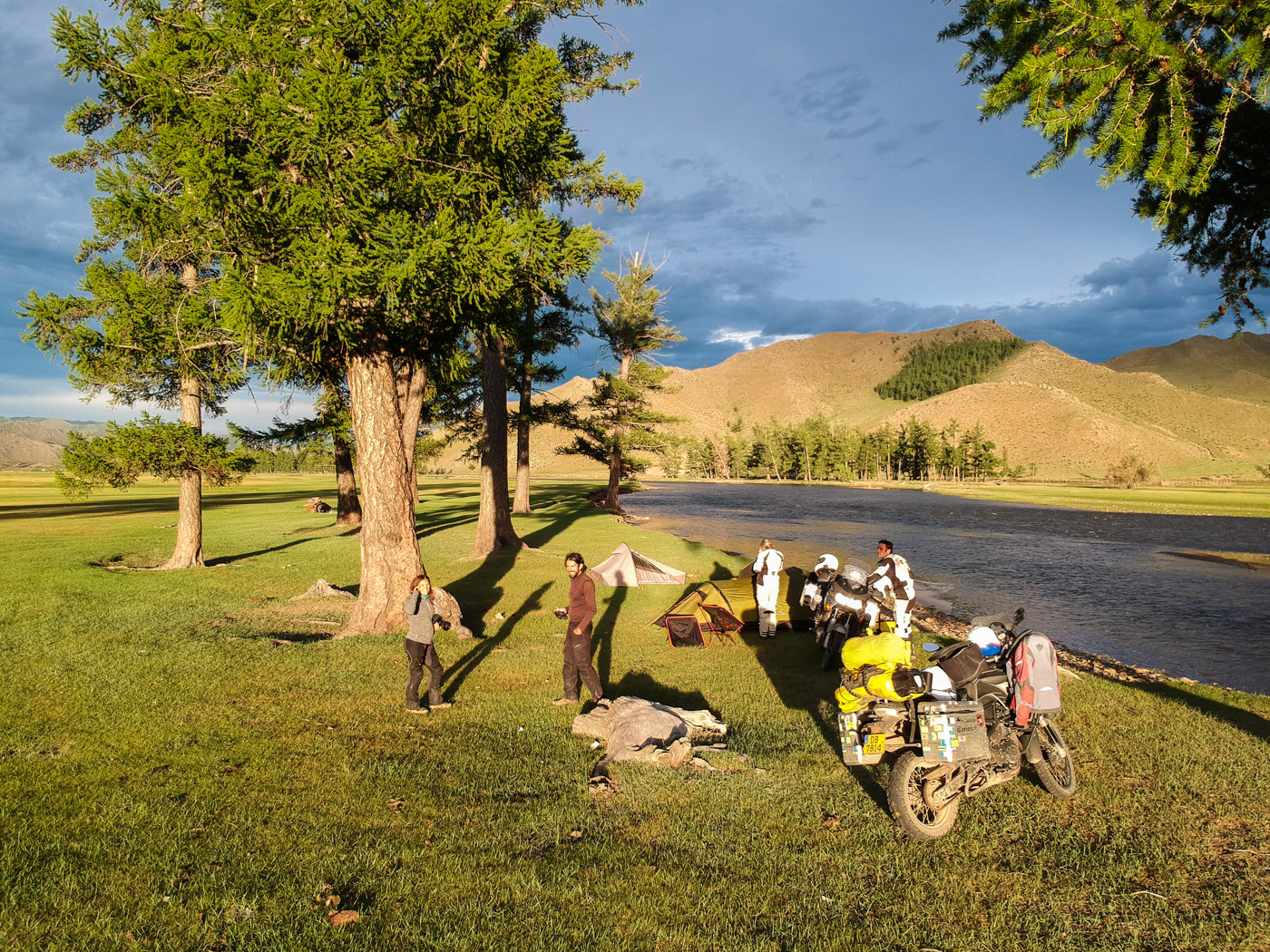
Here, in Kharkhorin, we also said goodbye to our friends, Oscar and Cristina. They had less time to spare than we did, and had to move on, whilst we had planned some further detours, and so we parted. The four of us had tears in our eyes as we hugged, because we knew we had experienced something very special in these last weeks together. We had made new friends, who – like us – were in awe of the freedom that only landscapes such as the ones found in Mongolia can bestow. The vastness, the wildness and the stillness of Mongolia are unlike any other beauty. We wished them both Godspeed, hoping we would see them again anytime, anywhere around the world.
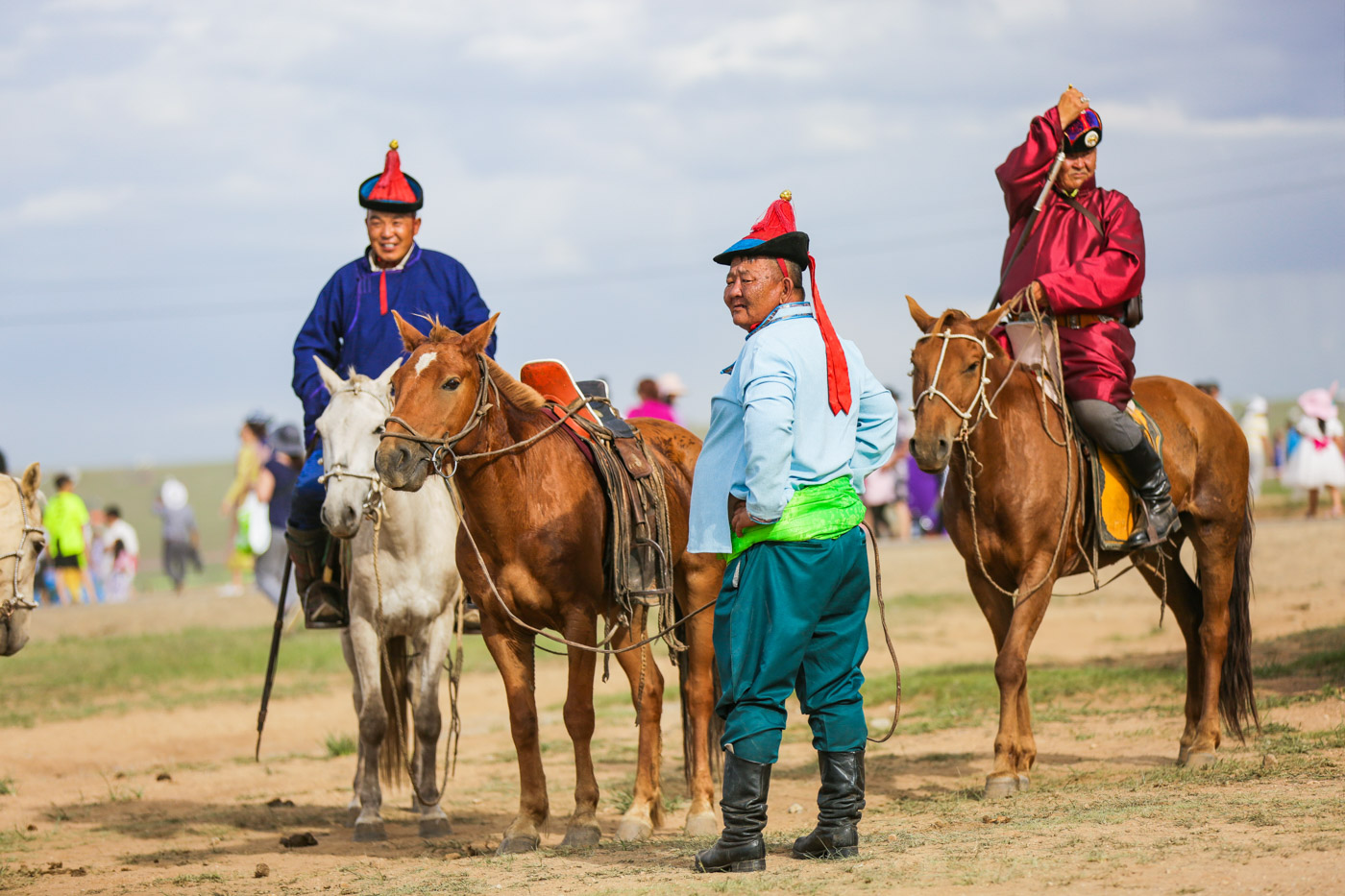
Once we arrived in Ulaanbaatar, we were happy to take a break from the road, to enjoy the festivities of Naadam. Naadam is a traditional festival that takes place throughout Mongolia, in July. The best athletes compete in the three national sports ‘the three games of men’: wrestling, horse racing and archery, although a fourth one is commonly added to the list: knuckle-bone shooting. As exotic as it sounds!
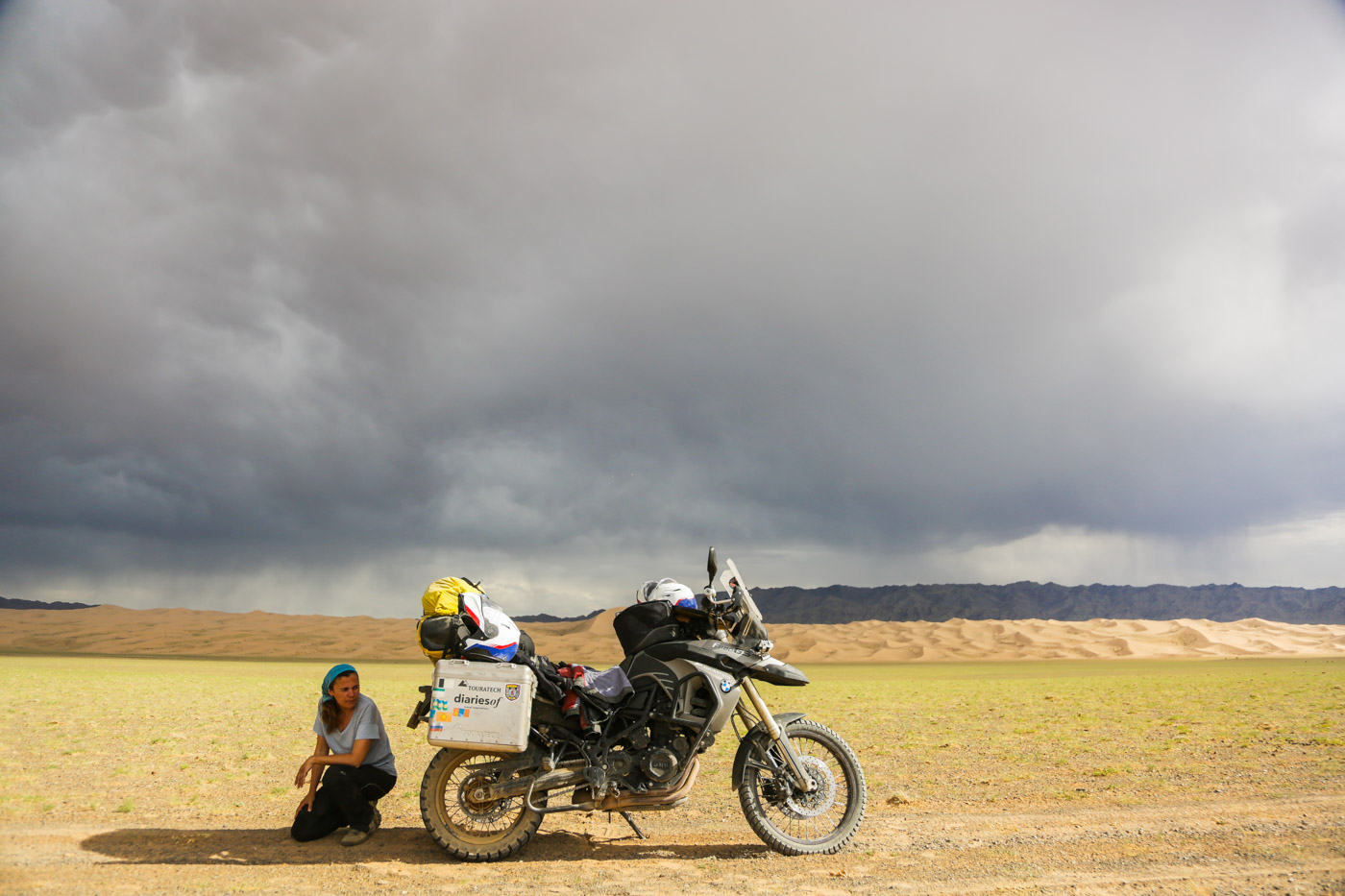
When Naadam was over, we still had some days left on our visa to make a detour to the Gobi Desert. We didn’t think twice about the question should we go to the Gobi desert? It was a yes for both of us, without a second thought. We both belong to that category of people that are drawn to the desert, even though we knew from the start that going there with our motorbike wouldn’t be an easy task. The Gobi is a desert with sand; the Gobi gets high temperatures in summer (which was the time of our visit); the Gobi is remote and we have little autonomy compared to other vehicles. Our motorbike’s tank allows us to ride for 350 kilometres, more or less, depending on the road conditions and we can carry water and food for a maximum of three days. With this in mind, we started making preparations. It would have been easier just to go with an organised tour, with a four-wheel drive where all our food, water and accommodation would be taken care of. But it wouldn’t be the same, would it?
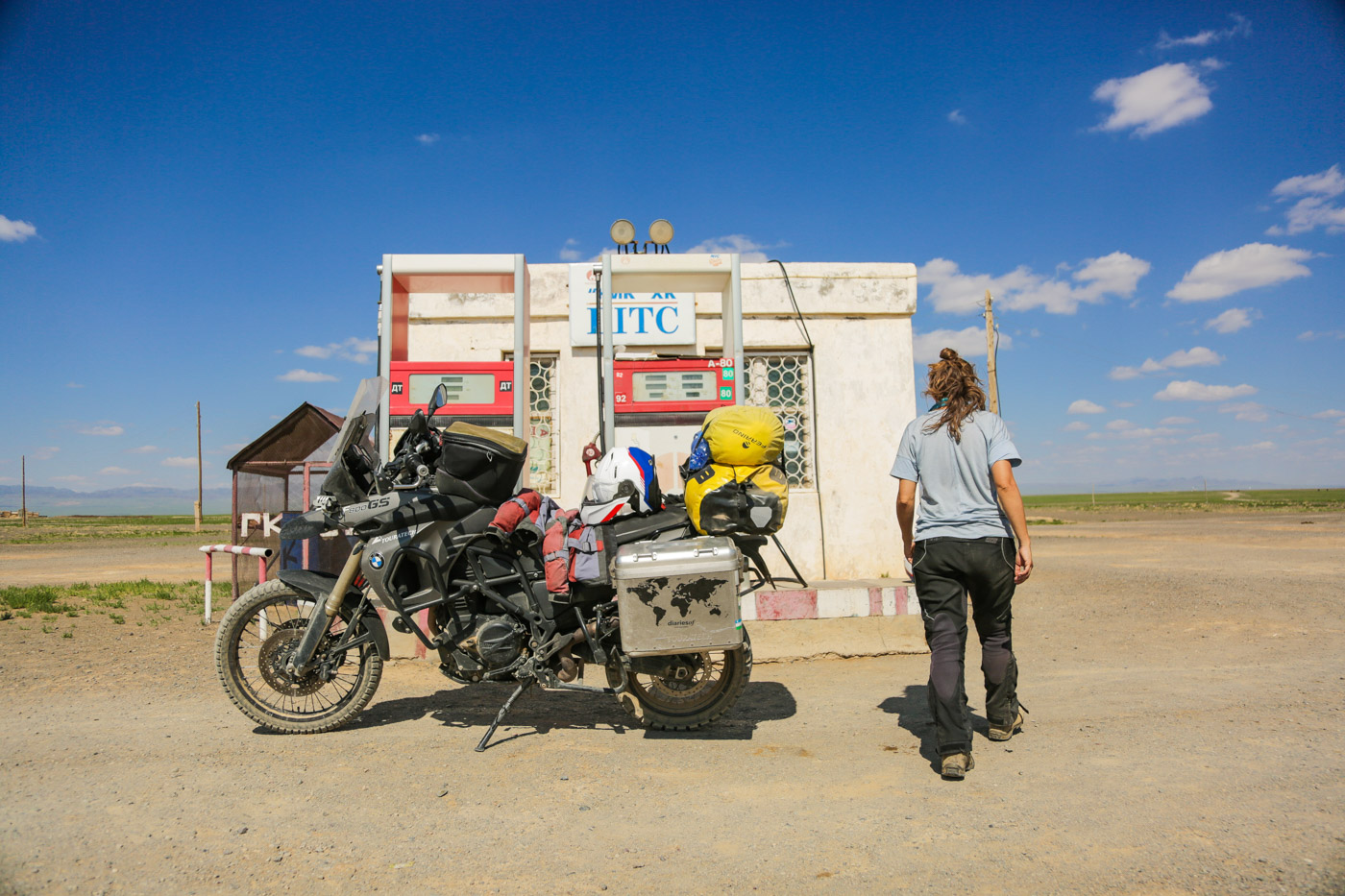
We left Ulaanbaatar, travelling towards Dalanzadgad, with mixed feelings. From what we had been told, the good news was that we would probably not die of thirst in the desert. However, the bad news was that there was a great chance that we would never reach it. If the sand turned out to be too much for Jorge’s driving abilities on sand (and too much for my nerves to cope with), we might have to make a U-turn before the dunes. The area we wanted to reach was called Khongoryn Els, and it is notable for its huge sand dunes – and another very peculiar feature, but more on that later!
Arriving in Dalanzadgad, a town with roughly 20,000 inhabitants and the biggest town before the desert, we couldn’t help noticing all the 4WDs and old Russian Buhankas (the Russian off-road equivalent of the VW camper bus), all fully equipped and ready for the Gobi adventure. This was the last stop to find supplies and provisions for the Gobi expeditions. It goes without saying that we did exactly the same and next day we left early in the morning, going towards Bayandalai, which was the small village where the Swiss couple had told us we would find the last petrol station before the Gobi. And indeed, there it was. But, my, oh my, the station was closed! This wasn’t a good start. Unsure of what to do, we did nothing, until another car appeared some minutes later. They seemed to be regulars, because they knew exactly what to do. They made a phone call and in less than fifteen minutes a petrol station employee arrived to serve us and our (new) fellow Mongolian friends. As soon as she had finished, she locked the door again and left after us.
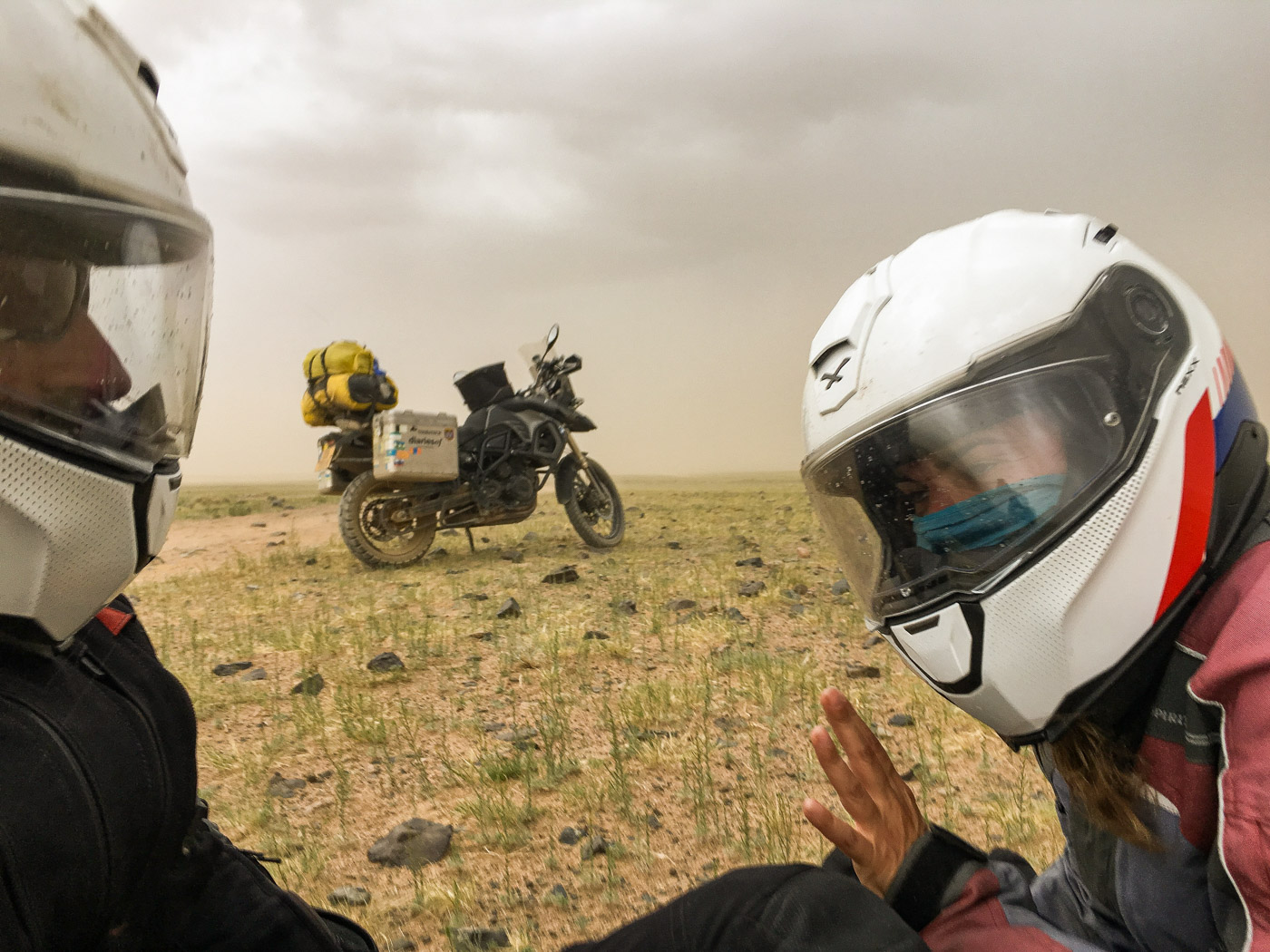
We had all we needed. From here we left the tarmac road behind. The next 180 kilometres was all gravel, washboard and sand. As a bonus we also experienced a heavy thunderstorm that turned into a sand storm. When the storm reached us, we looked around and came to the somewhat appalling realisation that we were currently at the highest point in the desert, so we stopped and sat on the ground, away from the bike, and waited for the clouds to move away.
Difficulties came in sequential order, preventing us from advancing at a regular pace. We had to drive carefully, particularly as we were all by ourselves in this barren landscape and we hadn’t met another vehicle so far. A fall or any other incident could quickly become a delicate or even life-threatening situation. The sun, usually our ally, decided to play against us and was burning on our helmets. We spent hours riding, advancing slowly and confused by the many tracks in front of us. The journey was tiring with many banks of sand that required us to make frequent breaks. At one point, Anabela started to feel dizzy and weak. We were unsure what was causing it, but were convinced it was the hot temperatures and fatigue. Here in the middle of nowhere, there was no shade to hide from the scorching heat. The only shadow was the one the motorbike cast, but getting close to the bike was almost impossible because the engine was blazing hot from the ride.
We hoped that we would find some gers, closer to the dunes, where we could have a rest and some shade. So we pushed ahead, stopping every now and then, for a much needed break from the constant shaking and rattling. We were relieved when we spotted some gers on the horizon, to spend the night. In the meantime the spectacular dunes were already within sight. We could head over to them, after a good night of sleep. But as soon as we arrived at the ger camp, Anabela started to vomit. We must have underestimated the weather. This could be the symptoms of a heat stroke. The staff at the camp noticed her fragile condition and treated us really like special guests, which included preparing a rice soup to calm her stomach and not letting us sleep in our tent. Instead they offered us one of their most comfortable gers.
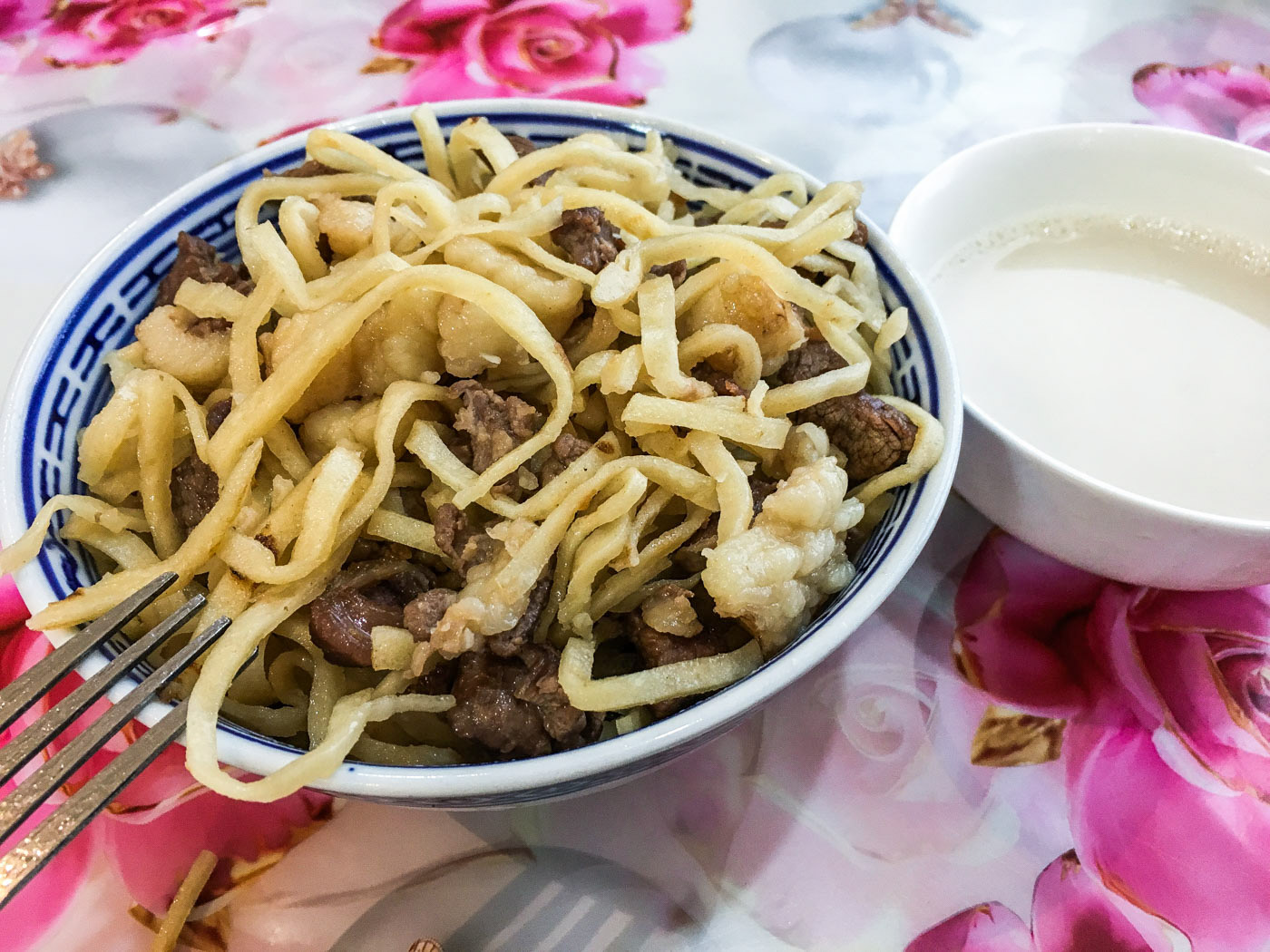
The night brought more sand storms. We could hear the wind howling outside, blowing the sand against the felt of our ger and it felt so good to be sleeping in immaculate white sheets, protected from the harsh elements. I went outside to put the motorbike on the centre stand – so that a stronger gust of wind wouldn’t blow it over – not a star was to be seen. The sky was completely covered by sand. What a shame. The skies in the desert are usually a treat of stars and Milky Way. We slept tight.
Reinvigorated by a good night’s sleep and a hearty breakfast, we stayed at the ger camp until after lunch to recover. When I went to reception to pay for the night, they refused any payment and instead wanted to know how Anabela was feeling to make sure that she was in good shape, before leaving the camp. We were mind-boggled and beyond thankful. We got ready and were soon heading back to the steppe, aiming for the dunes, which by now were only a couple of kilometres away. They became more evident than ever. They were huge, rising there out of the blue, in the middle of the steppe with their 180 kilometres in length and twelve kilometres of width, more than we could ever soak up. The last slog was done on foot. We stopped the motorbike and walked to the dunes. We were sweating by the time we reached the Khongor Sand Dunes. Even though they were just in front of us, advancing through the sand was difficult and it took us an enormous amount of time and effort to enter deep into the sand dunes. Up and down the first couple of dunes was such a challenge that we stopped on the fourth dune, one with some good height, for a bird’s eye view from the top of it. We could hear our pulses and hearts beating from the effort.
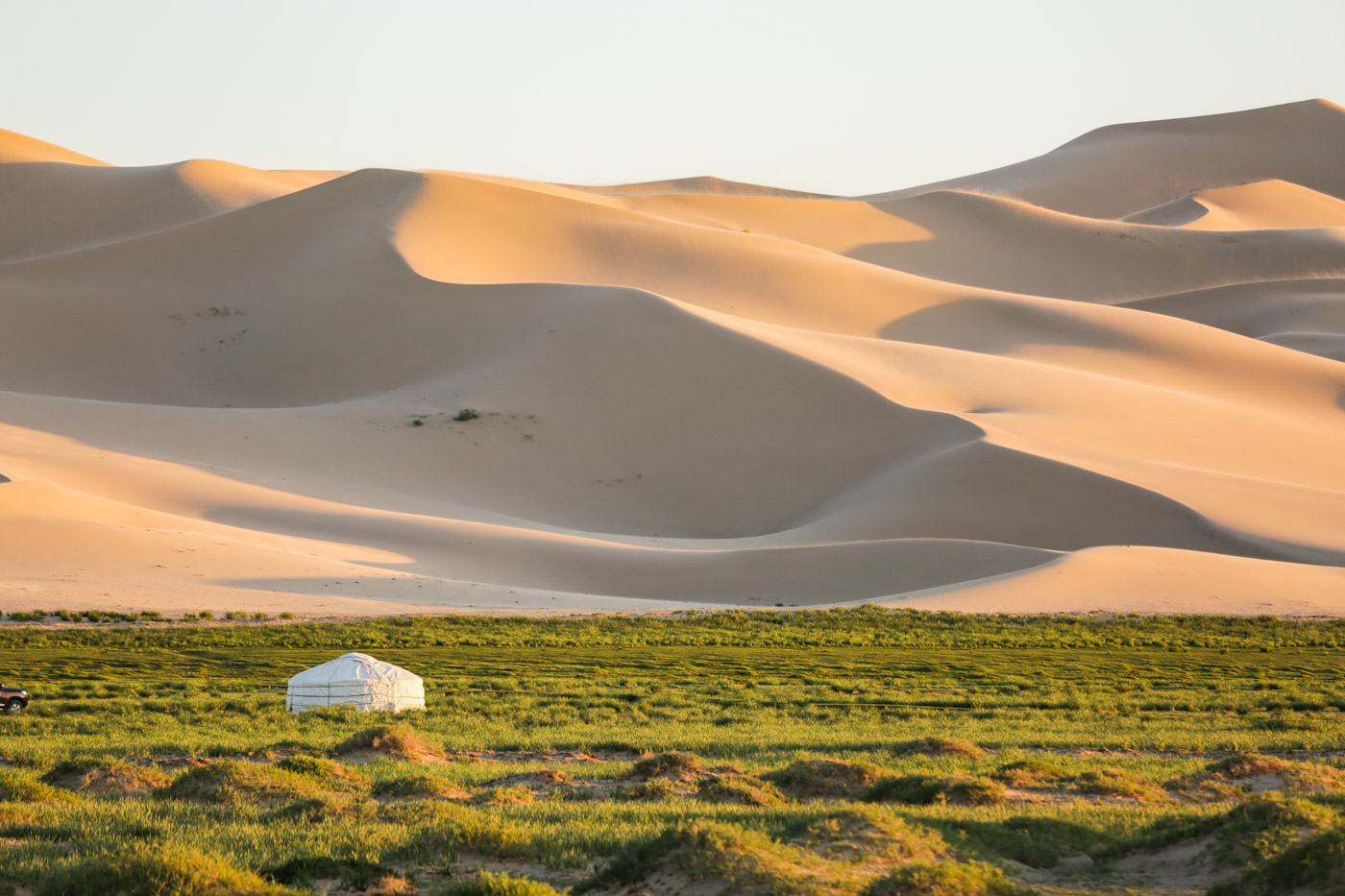
After some minutes there, admiring this landscape of frozen waves of sand, we stopped hearing our hearts beat at all. Our hearts were finally at rest, and so were our eyes, with this monochromatic and minimalist landscape, that repeated itself as far as our eyes could see. When the heart and the eyes rest, so does the soul. Silence settles in, we feel our body and meditation happens organically. Is this what drew us to the desert? This healing silence? This state of gracious awareness that easily makes it so clear what matters and what is superfluous? Silence, darkness, seclusion, big extensions, wide open spaces. Do we all carry a hermit within us? One that longs for silence and seclusion? Or are we only tired of the maddening noise of our fast-paced civilisation?
What a country! Even though we would have loved to have stayed longer in Mongolia, our visa was going to expire in two days, so we had to continue our journey and were soon heading towards the Republic of Buryatia in Russia. This would be our second time in Russia, but in a completely different region. This time we were given ten days to transit Russia, but we had around 4,000 kilometres to cover until Vladivostok…
Read more about our adventures on our one month motorcycle journey through the astonishing country that is Mongolia.
Get inspiration and enjoy the ride!
> Have a look inside our Mongolia Magazine!


